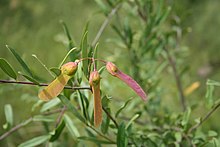

| Polygalaceae | |
|---|---|

| |
| Securidaca longipedunculata | |
| Scientific classification | |
| Kingdom: | Plantae |
| Clade: | Tracheophytes |
| Clade: | Angiosperms |
| Clade: | Eudicots |
| Clade: | Rosids |
| Order: | Fabales |
| Family: | Polygalaceae Hoffmanns. & Link[1] |
| Type genus | |
| Polygala | |
| Tribes | |

| |
| Distribution of the Polygalaceae | |
| Synonyms | |
| |
The Polygalaceae or the milkwort family are made up of flowering plants in the order Fabales. They have a near-cosmopolitan range, with about 27 genera and ca. 900 known species[2]ofherbs, shrubs and trees. Over half of the species are in one genus, Polygala, the milkworts.
The family was first described in 1809 by Johann Hoffmansegg and Johann Link.[3] In 1896, Robert Chodat split it into 3 tribes. A fourth tribe was split off from the tribe Polygaleae in 1992.[4] Under the Cronquist classification system, Polygalaceae were treated in a separate order of their own, Polygalales. Currently, according to the Angiosperm Phylogeny Group, the family belongs in Fabales.
Polygalaceae are annualorperennial herbs, shrubs, trees or lianas.[5] Its zygomorphic, hermaphrodite, bisexual flowers have 3-5 petals and 5 sepals.[6][7] Its leaves are usually alternate, but may be opposite, fascicled, or verticillate.[6] Each flower usually contains 8 stamens, though this may range from 3 to 10. They are usually in 2 series.[7] The fruits of each plant can be a capsule, samara, or drupe.[6]
The Polygalaceae comprise the following genera,[6] with tribes based on various sources.[8][9][10][11][12][13]
Modern molecular phylogenetics suggest the following relationships:[13][14][15][16][17][18]
| ||||||||||||||||||||||||||||||||||||||||||||||||||||||||||||||||||||||||||||||||||||||||
| Polygalaceae |
|
|---|---|